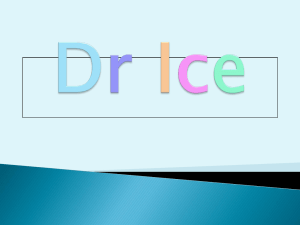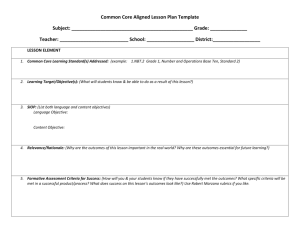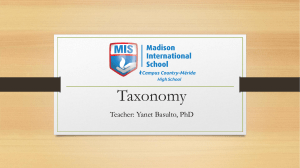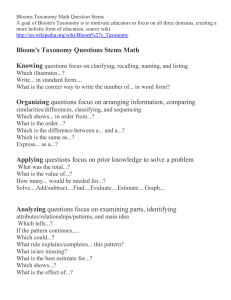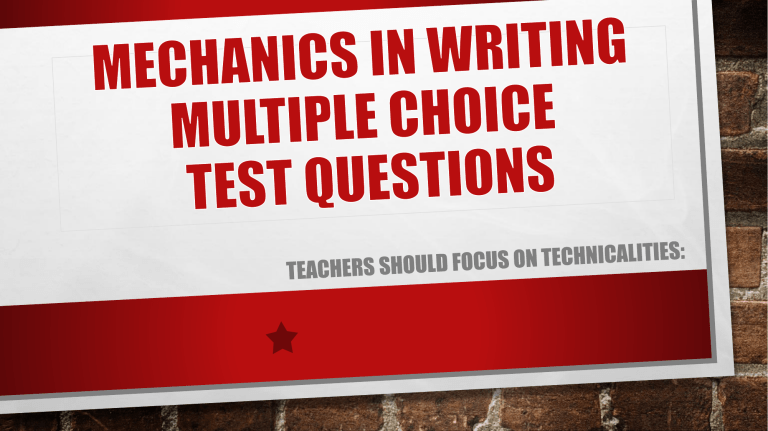
PARTS OF A QUESTION STEM- consist of the problem or introductory sentence. ALTERNATIVES- suggested solutions consist of : 1. Best Alternative- or the correct answer 2. Distractors- the incorrect or inferior answers. Multiple Choice should have/be: 1. Versatile/Versatility -MC should assess various levels of learning outcomes -MC does not effectively measures the learners in organizing thoughts like essay type. -learners are not require to articulate in their answers. Multiple Choice should have/be: 2. Reliability -if consistent, focus on single learning objective. -it becomes negative- because learners are made to answer the letters only. 3.Validity -If it measures the learning outcome it suppose to measure. -If it can be answered quickly. -If it focus on the topic itself. THE STEM: Should be meaningful by itself- do not use incorrect phrases or incomplete sentence. Blanks should be used sparingly- unless necessary Present a clear problem/ sentence WH signal word are not necessary as long as it is using correct sentence THE STEM: Use complete stem then blank. Example: The movie entitled____________ is the most ( emphasized the topic) the blank can be in the middle or first part THE STEM : Should not contain irrelevant material- for this could decrease realibility, validity etc. Example: Too long sentences (2 or 3) it just prolong the sentence questions but not necessary. THE STEM : Should not be negatively stated/ unless only when significant learning outcome is required. - Unless appropriate Example: None of the above/ All of the above. Avoid (Which of the above, All of the above) negatively phrasing THE STEM : Should present a definite problem Ex: Which of the following is the true statement? a. Mitochondria_________________________ _________________________ b. _______________________________________ REVERSE THE QUESTION: Mitochondria is_________________________ a.______________________________ b.______________________________ c.______________________________ THE ALTERNATIVES: ALTERNATIVES should be plausible (believable, credible) -avoid options w/c are out of the box ex: a. neutrons Making the b.protons alternative c.electrons implausible d. avocado- not a functional distractor THE ALTERNATIVES: ALTERNATIVES should not use WORDLY options Should be clearly stated and concise ( free from all elaboration & superflows details- capsulate, compact) Should be simply stated ( because we are not measuring the pupils reading ability) THE ALTERNATIVES: ALTERNATIVES should be mutually exclusivedo not overlap the meaning of one another. Ex: How many chromosome are found in a a. 12 b. 24 c. 32 d. 41 Can be correct THE ALTERNATIVES: To be exclusive: How many chromosome are found in a womans body- needs exact number Should be homogeneous in content avoid same phrases ex: be able to read be able to write add this to stem THE ALTERNATIVES: ALTERNATIVES should be free from CLUES of the correct answer Grammar should be consistent with the stem The length format- parallel in form if possible should be similar in length Language choice- similar language THE ALTERNATIVES: ALTERNATIVES should be presented in logical order- It could be arrange in alphabetical order Avoid bias toward certain position Avoid Multiple choices which are complex items Keep specific content independent from one another If possible have 4 options: 1- correct answer 3- distractors BLOOMS TAXONOMY OF COGNITIVE DOMAIN REMEMBERING UNDERSTANDING APPLYING ANALYZING EVALUATING CREATING BLOOMS TAXONOMY OF COGNITIVE DOMAIN Remembering- recognize or recall facts is when memory is used to produce definition, facts or list or to recite or retrieve information BLOOMS TAXONOMY OF COGNITIVE DOMAIN Remembering oCan the pupil recall the information? oSimply recalling- no explaination BLOOMS TAXONOMY OF COGNITIVE DOMAIN Understanding- explain idea / concept is about constructing meaning from different types of functions, be they written or graphics. BLOOMS TAXONOMY OF COGNITIVE DOMAIN UnderstandingoCan the pupil explain the ideas and concept they have remembered BLOOMS TAXONOMY OF COGNITIVE DOMAIN Applying- solve new problem with existing knowledge refer to situation where the learned materials are used in products such as diagrams, models, interviews, simulations and presentations. BLOOMS TAXONOMY OF COGNITIVE DOMAIN ApplyingoCan pupils use their knowledge & understanding in a new concept. BLOOMS TAXONOMY OF COGNITIVE DOMAIN Analyzing- examine distinction/ connection between ideas is about breaking materials into parts interrelated to each other or to an overall structure or purpose. BLOOMS TAXONOMY OF COGNITIVE DOMAIN AnalyzingoCan pupils distinguish between the different parts an understand how they are connected? BLOOMS TAXONOMY OF COGNITIVE DOMAIN Evaluating- defend & explain a stand or decision is about making judgement based on criteria and standards through checking and critiquing. BLOOMS TAXONOMY OF COGNITIVE DOMAIN EvaluatingoCan pupils justify a stand or decision, explain which options are better than the other and why? BLOOMS TAXONOMY OF COGNITIVE DOMAIN Creating- generate original work is about putting elements into a new structure or pattern by planning or producing. BLOOMS TAXONOMY OF COGNITIVE DOMAIN CreatingoCan pupils build on the lower order skills to create a new product or ideas that are useful?
